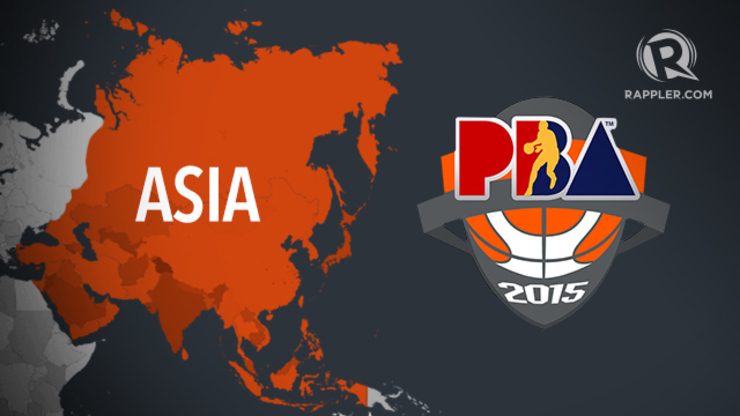SUMMARY
This is AI generated summarization, which may have errors. For context, always refer to the full article.

MANILA, Philippines – Slowly, steadily, the Philippine Basketball Association (PBA) is opening itself to Asia.
The 40-year-old league has plans to bring in Asian reinforcements to play alongside locals and imports in the season-ending Governors’ Cup conference in its coming season. The plan is to give each of the current 12 teams the option of including at least one Asian player to its roster. And while there are no definitive guidelines just yet, this is seen as an experiment that will gauge the league’s readiness to stretch out its wings and evolve into a bigger and better pro basketball league.
But this move is only the beginning. The be all and end all is for Asian brands to advertise in the league, or better yet, to join the PBA with their own teams.
“(The ultimate goal is) for brands to advertise, for brands to even decide to join,” said Patrick “Pato” Gregorio, current PBA Chairman and alternate governor to PBA team Talk ’N Text Tropang Texters.
“If I can invite a top player from Taiwan, maybe Acer will advertise. (And perhaps) Toshiba for Japan, etc,” he also said in a separate interview. “It’s time to grow, slowly, but it’s a good time to experiment.”
The idea is for the PBA to make itself attractive and marketable enough for brands to invest in – whether through ad spots, sponsorships, or teams. To do this, the league must expose itself to the rest of the continent and make itself an inclusive, available, and global entity. And the PBA has already begun dipping its toes in the pool.
There have been reports the PBA is exploring the possibility of playing a regular season game in Seoul, South Korea. A partnership with the Korean Basketball League (KBL) is also a possibility, as well as the prospect of KBL and PBA cagers playing as imports for each other’s leagues.
This past September, KBL team LG Sakers and PBA team Barangay Ginebra played a highly-publicized and well-received exhibition game in Manila. PBA teams San Mig Coffee and Globalport traveled to Korea this preseason to play against some of the teams there.
The PBA won’t have to wait for its 50th year before it sees Asian brands coming in. Gregorio envisions it happening within the next 3 to 5 years.
While Gregorio concedes there will be some birth pains and speed bumps, he points out one significant benefit of a more globalized PBA: it exposes Filipino brands – such as those who have teams in the league – to other countries as well.
“In the business sense, one major reason why we are in the PBA is to help us promote our brands. If we can also promote our brands outside of the Philippines using our PBA, why not?”

All this starts with what Gregorio calls “Asian integration.”
The league’s Board of Governors together with PBA Commissioner Chito Salud already had a brainstorming session in South Korea earlier this month regarding the Asian reinforcements. They plan to convene once again in November to finalize implementing rules and guidelines, though reports say there will be a height limit of 6-foot-4 for Asian players.
Gregorio also explained the Asian players will not get in the way of the traditional imports that each team employs during the third conference.
“An import is an import. We will keep that. It’s a tried and tested format,” he said. “But the Asian integration is a new experiment. We need to transform. We need to check if really the PBA is a big hit. We are confident it will be a big hit.”
Though this early, he is already optimistic about other Asian players’ enthusiasm in participating in the PBA, especially after the Philippines showed the world its tremendous love for basketball during the 2013 FIBA Asia Championship and in this year’s FIBA World Cup.
“It’s a very big market out there. These Asian players, I am confident, they will be too excited to play in the Philippines.”
Taking the cue from ASEAN 2015
With the ASEAN integration set to commence in 2015, the PBA sees it as an inspiration and an opportunity.
“The PBA is also preparing for this (ASEAN) integration. If we can do it in business, why can’t we do it in sports?”
Business-wise, just as local brands will reap the benefits of a more globalized PBA, regional brands with teams in the league, such as San Miguel Corp., can also increase their exposure within the region and beyond.
Gregorio specifically cites the case of expansion team Blackwater.
“Blackwater is now expanding in Indonesia. Is it not a good strategy to identify in the future a good Indonesian player so that you can push your brand in Indonesia?”
And with the ASEAN Economic Community – where the region will essentially be transformed into “a single market and production base,” which makes trade much simpler and easier – one of the major highlights of the 2015 ASEAN integration, there is all the more reason for brands advertising or participating in the PBA to want to create more exposure to the region.
“The other main reason (teams stay in the PBA) is advertising, marketing, promotions. With the ASEAN trading, if I can promote all these products in the ASEAN region, the exposure is better,” Gregorio explained.
Teams in the PBA do, in fact, stay for a long time as they’ve created their identity, cemented their legacy, and built a strong fan base – even as they switched team or brand names from time to time. These longstanding teams include Barangay Ginebra San Miguel, the Alaska Aces, and the Talk ’N Text Tropang Texters.
The Rain or Shine Elasto Painters, who joined the league in 2006 after many years with the now-defunct semi-pro Philippine Basketball League, is just one proof of how the PBA is a unique and effective marketing and advertising tool for brands. Since joining, they’ve become top of mind in retail for elastomeric paints, according to team owner and businessman Raymond Yu in an interview with Business World.
Players generate brand awareness and are essentially brand ambassadors. While brand recall is attained – especially if the team is winning – with constant broadcast and media mileage with each game throughout the year.
As far as players are concerned, it’s not just Korean, Iranian or Taiwanese players that are considered prospects, like many would expect. The integration bodes well for the country’s Southeast Asian neighbors as Gregorio is also eyeing Indonesian or Malaysian players, giving ample two-way exposure and experience to ASEAN and local players.
But it doesn’t end with the Southeast Asian region. If preseason team activities are any indication, Korea is likely the next frontier.
Tapping Korean market
Current social and popular culture trends further suggest the Korean opportunity for the league. For one, Filipinos’ fascination over everything Korean could mean locals will take to Korean basketball players a little easier. The PBA can also venture into the untapped market of Koreans living and studying in the country.
That’s also not to mention that Koreans were the top tourists in the Philippines in 2013 with 1.17 million arrivals.
“If you analyze what’s happening, even to the other brands in the other industries, you see Korean endorsers promoting (brands like) Bench,” Gregorio explained. “We Filipinos have accepted that. Primetime TV is full of Koreanovelas. Yun yung gusto natin subukan, yun yung gusto natin palawakin.” (That’s what we want to try, that what we want to explore.)
Korean car manufacturer KIA, which will be making its PBA debut with its team KIA Sorento this season, can benefit greatly from Asian integration.
“Can you imagine the one million Koreans living in the Philippines watching the PBA? If I can just tap 5 thousand Koreans every time there’s a KIA game, that’s incremental,” Gregorio added.
Ultimately, everything the PBA does with regard to this Asian integration is driven by a single vision, which will hopefully be realized soon enough.
“I want to see the PBA as an Asian brand,” Gregorio said.
“After all is said and done, when you realize the impact of this plan, it is really good. Not just for Philippine basketball, it will be good for Philippine business.”
More importantly, this pushes the successful league to take the next step.
“We tell everybody we are Asia’s first professional league. Let’s push it. Let’s grow. Let’s not allow any league to overtake us.” – Rappler.com
Add a comment
How does this make you feel?
There are no comments yet. Add your comment to start the conversation.